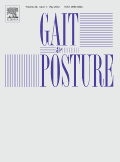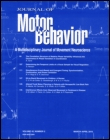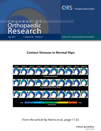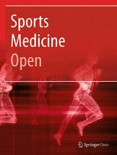
GAIT & POSTURE
Scope & Guideline
Connecting Research and Practice in Biophysics and Orthopedics
Introduction
Aims and Scopes
- Biomechanics of Gait and Posture:
Research in this area includes the analysis of joint kinematics and kinetics during walking, running, and other physical activities, utilizing advanced technologies such as 3D motion capture and wearable sensors. - Clinical Interventions and Rehabilitation:
The journal frequently publishes studies on interventions for improving gait and posture, including the effectiveness of orthoses, rehabilitation exercises, and robotic assistance for patients with various conditions. - Neurological and Musculoskeletal Disorders:
A significant focus is placed on understanding how neurological (e.g., Parkinson's disease) and musculoskeletal disorders (e.g., osteoarthritis) affect gait and posture, with studies investigating underlying mechanisms and rehabilitation strategies. - Gait Analysis Technology:
The journal highlights advancements in gait analysis technologies, including machine learning and wearable sensors, to enhance the accuracy and efficiency of gait assessments in both clinical and research settings. - Aging and Pediatric Gait Development:
Research on how gait changes with aging or develops in pediatric populations is a key area, providing insights into the normative patterns and deviations seen in different age groups. - Cognitive and Behavioral Influences on Gait:
Exploration of how cognitive tasks, emotional states, and environmental factors impact gait and postural control, emphasizing the interplay between motor and cognitive functions.
Trending and Emerging
- Machine Learning and Artificial Intelligence in Gait Analysis:
An increasing number of studies are utilizing machine learning techniques to analyze gait data, providing innovative ways to interpret complex movement patterns and predict outcomes. - Wearable Technology and Remote Monitoring:
The integration of wearable devices for continuous monitoring of gait and posture is on the rise, enabling real-time data collection and analysis in naturalistic settings. - Multidisciplinary Approaches to Gait and Posture:
There is a growing trend towards interdisciplinary research, combining insights from biomechanics, neuroscience, psychology, and rehabilitation to create a holistic understanding of gait and posture. - Impact of COVID-19 on Gait and Mobility:
Research focused on the effects of the pandemic on mobility, physical activity, and rehabilitation outcomes has emerged, addressing new challenges faced by different populations. - Focus on Pediatric and Geriatric Populations:
There is an increasing emphasis on understanding gait and posture in pediatric and geriatric populations, reflecting the need for tailored interventions and assessments for these age groups. - Cognitive and Emotional Influences on Movement:
Research examining how cognitive load, emotional states, and dual-tasking impact gait and posture is becoming more prevalent, emphasizing the importance of mental factors in physical performance.
Declining or Waning
- Traditional Gait Assessment Methods:
There is a noticeable decrease in studies relying solely on traditional gait assessment methods, such as visual observational techniques, as newer technologies and analytical methods gain prominence. - Basic Kinematic Studies:
Research focusing exclusively on basic kinematic parameters without integrating advanced biomechanical analysis or clinical implications has declined, indicating a trend towards more comprehensive studies. - Single-Domain Studies:
There has been a waning interest in studies that focus solely on one aspect of gait or posture, such as only examining kinematics without considering kinetics or electromyography. - Descriptive Studies Without Clinical Application:
The journal has shifted away from purely descriptive studies that do not translate into clinical implications, favoring research that provides actionable insights for rehabilitation and therapy. - Cross-sectional Studies Without Longitudinal Follow-up:
There is a reduction in the publication of cross-sectional studies that do not include longitudinal follow-up, as the field increasingly values studies that track changes over time.
Similar Journals

Advanced Biomedical Engineering
Unleashing potential through open access research.Advanced Biomedical Engineering is a peer-reviewed open access journal published by the Japanese Society for Medical & Biological Engineering, dedicated to disseminating high-quality research in the multidisciplinary fields of biomedical engineering. Boasting an ISSN of 2187-5219, this journal has been pivotal since its inception in 2018, especially as it embraces the open access model to foster knowledge sharing and wide accessibility. Centered in Tokyo, Japan, it serves as a vital platform for scholars and practitioners across various domains, such as biomaterials, biomedical engineering, and biotechnology. Despite currently residing in the Q4 quartile across several categories, including those in biotechnology and computer science applications, the journal is committed to elevating its academic impact and reputation, aiming for improved rankings in Scopus and other databases. Researchers and professionals are encouraged to contribute their innovative findings, discussions, and case studies, facilitating the advancement of this dynamic field.

MLTJ-Muscles Ligaments and Tendons Journal
Innovating Orthopedic Insights for Better OutcomesMLTJ-Muscles Ligaments and Tendons Journal, published by EDRA SPA, is an influential peer-reviewed journal dedicated to advancing knowledge in the fields of orthopedics and sports medicine. With a strong focus on the biomechanics, pathology, and treatment of musculoskeletal disorders, MLTJ serves as a vital resource for researchers, clinicians, and students alike. The journal is indexed in Scopus and has achieved a respectable Q3 quartile ranking in its category for 2023, positioning it among the competitive publications in the field. Although the journal utilizes an open access model, it remains committed to the dissemination of high-quality research, thus facilitating a broader impact on practice and education. With converged publication years spanning from 2011 to 2024, MLTJ continues to build its reputation as a critical platform for innovative studies and clinical advancements, contributing significantly to the understanding and treatment of musculoskeletal health.

Journal of Human Kinetics
Advancing knowledge in human kinetics and rehabilitation.The Journal of Human Kinetics, with its ISSN 1640-5544 and E-ISSN 1899-7562, is a leading open-access journal published by TERMEDIA PUBLISHING HOUSE LTD in Poland since 2008. This journal serves as a premier platform for the dissemination of innovative research and insights in the fields of Physical Therapy, Sports Therapy and Rehabilitation, as well as Physiology and Sports Science. With a distinguished Q1 ranking in Physical Therapy and Rehabilitation and Q2 rankings in both Physiology and Sports Science for 2023, it holds a reputable position in scholarly communication, attracting high-quality contributions from researchers and professionals worldwide. The journal, open to a global audience, allows unrestricted access to its content, ensuring that critical advancements in human kinetics reach practitioners and academics alike. The sustained growth of its impact reflects the journal's commitment to fostering knowledge and promoting collaboration within these vital fields, highlighting its importance as a resource for students and professionals aiming to stay at the forefront of research and practice.

JOURNAL OF MOTOR BEHAVIOR
Unraveling the Science Behind Motor BehaviorJOURNAL OF MOTOR BEHAVIOR, published by Routledge Journals, Taylor & Francis Ltd, is a leading platform that explores critical insights into the dynamics of motor functions and behavior across various disciplines including biophysics, cognitive neuroscience, and sports science. With an ISSN of 0022-2895 and an E-ISSN of 1940-1027, this journal has been a vital resource since its inception in 1969, offering a comprehensive analysis of motor control, skill acquisition, and the neural mechanisms underlying motor performance. Positioned in the Q3 quartile across multiple categories for 2023, it ranks competitively within its fields, such as #136 in Orthopedics & Sports Medicine and #95 in Experimental & Cognitive Psychology. JOURNAL OF MOTOR BEHAVIOR serves not only as an essential reference for researchers and professionals but also as an invaluable resource for students pursuing studies in motor behavior and related areas, reflecting the ongoing evolution and significance of this field in enhancing our understanding of human movement and performance.

Revista Internacional de Medicina y Ciencias de la Actividad Fisica y del Deporte
Empowering Research in Rehabilitation and Sports TherapyRevista Internacional de Medicina y Ciencias de la Actividad Fisica y del Deporte, published by RED IRIS in Spain, is a pivotal Open Access journal dedicated to advancing the fields of physical medicine and sports science. Since its inception in 2000, this journal has provided a platform for researchers, professionals, and students to disseminate innovative findings and critical insights pertaining to physical therapy, sports therapy, and rehabilitation practices. Positioned in the Q3 quartile for Physical Therapy and Rehabilitation and Q4 quartile in Sports Science as of 2023, the journal reflects a growing commitment to academic rigor and evidence-based practices. Indexed in Scopus with a notable rank in the health professions, the journal continues to foster a community of scholarly exchange and knowledge, making significant contributions to both academic discourses and practical applications in the field.

Bulletin of the Hospital for Joint Diseases
Bridging Disciplines for Better OutcomesBulletin of the Hospital for Joint Diseases is a reputable journal focused on the interdisciplinary domains of Orthopedics, Rheumatology, Surgery, and related fields, published by J Michael Ryan Publishing Inc. Since its inception in 2013, this journal has become a pivotal source for clinicians, researchers, and students aiming to advance their knowledge and practice in joint diseases and musculoskeletal disorders. Although categorized in the lower quartiles of Medicine and Orthopedics, it serves a unique niche that fosters meaningful discourse and innovation within the profession, offering valuable insights and promoting evidence-based practices. The journal's content is particularly beneficial for healthcare professionals involved in joint care, providing them with the latest research findings and clinical developments. With varied metrics indicating its standing within the medical community—ranked 409 out of 551 in Medicine/Surgery and 261 out of 321 in Orthopedics—Bulletin of the Hospital for Joint Diseases remains committed to disseminating knowledge that impacts patient care and improves surgical outcomes. The journal is not currently open access, ensuring that articles maintain a level of academic integrity while being accessible to a discerning readership.

JOURNAL OF ORTHOPAEDIC RESEARCH
Elevating Musculoskeletal Health Through Innovative ResearchThe JOURNAL OF ORTHOPAEDIC RESEARCH, published by WILEY, stands as a premier peer-reviewed journal in the field of orthopedics and sports medicine, showcasing high-impact research with a notable impact factor and categorized in the top Q1 quartile for 2023. Since its inception in 1983, this journal has continuously evolved to meet the needs of a dynamic scientific community, serving as a vital resource for researchers, clinicians, and students engaged in the study and practice of orthopedics. With commendable rankings, positioned at Rank #47 out of 321 in the Medicine Orthopedics and Sports Medicine category, and boasting a remarkable 85th percentile in Scopus rankings, it highlights groundbreaking studies and advances in orthopedic science. While not an open-access journal, it provides diverse access options to ensure that its contributions are available to a broad academic audience. The journal plays a crucial role in disseminating innovative ideas and fostering collaboration within the orthopedic research community, thereby promoting improved patient care and outcomes in musculoskeletal health.

BIOLOGY OF SPORT
Innovating Rehabilitation Through Sports ResearchBIOLOGY OF SPORT is a leading peer-reviewed journal published by TERMEDIA PUBLISHING HOUSE LTD, renowned for its significant contributions to the fields of sports science, orthopedics, and rehabilitation. Since its establishment in 1984, this Open Access journal has facilitated the dissemination of important research findings and clinical practices that advance our understanding of athletic performance and physical health. With an impressive Q1 ranking in key categories such as Orthopedics and Sports Medicine, Physical Therapy, and Physiology, BIOLOGY OF SPORT is recognized for its rigorous standards and high-impact contributions, boasting a 95th percentile ranking in several Scopus categories. The journal is committed to fostering interdisciplinary knowledge that bridges fundamental biology with practical sports applications, making it an invaluable resource for researchers, healthcare professionals, and students dedicated to improving health and performance in sports contexts. For more information, you can explore their offerings and access articles at their Poland-based headquarters: KLEEBERGA 2, POZNAN 61-615.

KNEE SURGERY SPORTS TRAUMATOLOGY ARTHROSCOPY
Exploring Ground-breaking Research in Knee SurgeryKNEE SURGERY SPORTS TRAUMATOLOGY ARTHROSCOPY is a premier academic journal published by Springer, dedicated to the fields of orthopedics, sports medicine, and surgery. With an impressive impact factor and ranked in the Q1 category across multiple disciplines, this journal is at the forefront of clinical and experimental research, providing invaluable insights into knee surgery and sports-related injuries. It has been a trusted resource since its inception in 1993, with a commitment to disseminating high-quality research and clinical findings that advance the practice and understanding of knee surgery. Researchers and professionals can expect to find ground-breaking studies and comprehensive reviews that are critical for improving patient outcomes in the ever-evolving landscape of sports medicine. Although not an open access journal, KNEE SURGERY SPORTS TRAUMATOLOGY ARTHROSCOPY remains a vital platform for scholarly discourse and innovation, shaping the future of orthopedic sports science.

Sports Medicine-Open
Transforming sports medicine through innovative research and collaboration.Sports Medicine-Open, published by Springer, is an esteemed open-access journal that has been a significant contributor to the fields of orthopedics and sports medicine since its inception in 2015. With an impressive impact reflected in its Q1 category rankings for both Orthopedics and Sports Medicine as well as Physical Therapy, Sports Therapy, and Rehabilitation, it stands at the forefront of these disciplines. This journal not only disseminates cutting-edge research and clinical insights but also encourages innovative applications in sports health and rehabilitation, making it an invaluable resource for researchers, healthcare professionals, and students alike. With its broad scope and high visibility (Scopus rankings placing it in the top percentiles), Sports Medicine-Open is dedicated to fostering knowledge sharing and collaboration in a rapidly evolving field. Access to this journal is made convenient through its commitment to open access, ensuring that critical research findings reach a global audience.